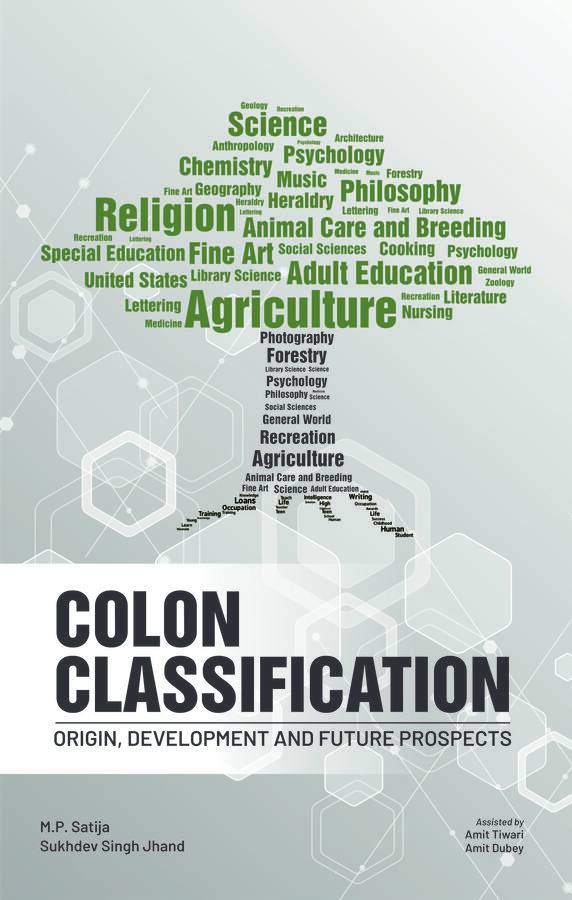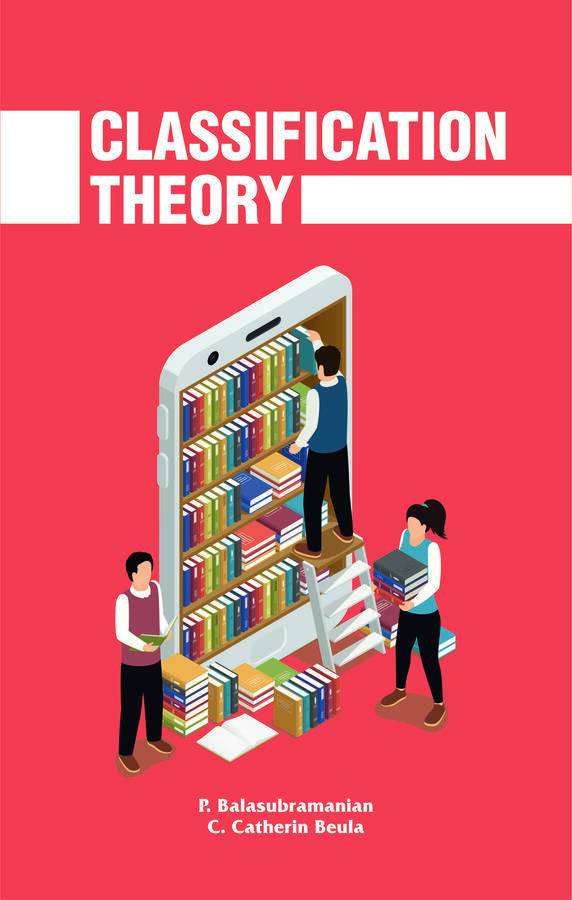Preface
List of Figures
List of Tables
List of Abbreviations
1 Influences on Colon Classification
1. Influence of Personalities
1.1. Edward B. Ross (1881-1947)
1.2. Professor S. KuppuswamiSastri (1880-1943)
1.3. E.C.Richardson (1860-1939)
1.4. W. C. Berwick Sayers (1881-1960)
1.4.1. Influence of Sayers was both overt
and covert.
1.4.2. Equivalence between the canons of
Sayers and Ranganathan
1.5. H. E. Bliss (1870-1955)
1.6. Childhood and Religious Influences
1.6.1. Role of Hindu Saints and Scriptures
2. Influence of Classification Systems
2.1. Influence of the DDC
2.1.1. DDC as the Practical Guide for the CC
2.1.2. Use of Decimal Fraction Notation
2.1.3. ’Sector Device’ of CC and ‘Other Device’
of DDC
2.1.4. Use of Synthesis in DDC and CC
2.1.5. Mnemonics in DDC and CC
2.2. Influence of UDC
2.2.1. Use of Synthesis in UDC and CC
2.2.2. Use of other Symbols
3. Influence of Mathematics on Colon Classification
3.1. General Aspects of Mathematics Used in the CC
3.1.1. Mathematics as a Field
3.2. Postulational Method
3.3. Use of Ordinal Numbers in Classification
3.4. Group Theory/Set Theory and Classification
3.5. Three Planes of Work
3.6. Facets and Infinite Dimensions
3.7. Mapping Facets of Subjects to a Notation
3.8. Frequent use of Mathematical Signs and Symbols
2 Genesis and Development of Colon Classification
1. Genesis
1.1. The Use of Symbol (:) Colon as “Greater Zero”
1.2. Role of Intuition and Creativity
1.3. Other Factors
2. Development of Colon Classification
2.0. Development of Version-1
2.1. First Edition of CC (CC-1)
2.1.1. Publication of CC-1
2.1.2. Salient Features of CC-1
2.1.3. Order of Main Classes in CC1
2.1.4. Comparison with the Tree of Porphyry
2.2. Second Edition of CC (CC2)
2.2.1. Introduction of New Main Class
2.2.2. Widening the Scope of Main Class ‘M’
2.2.3. Changes in Terminology
2.3. Third Edition of CC (CC3)
3. Development of Version-2
3.1. Fourth Edition of CC (1952)
3.2. Fifth Edition of CC (1957)
3.3. Sixth Edition of CC (CC6)
3.3.1. Sixth Edition (reprinted in 1963)
3.3.2. Sixth Reprinted Edition (reprinted in 1969)
4. Version-3 of CC (CC7)
4.1. Use of Alphabetical Device
4.2. Work in Three Planes
4.2.1. Changes in the Idea Plane
4.2.2. Changes in the Verbal Plane
4.2.3. Changes in the Notational Plane
4.2.4. Changes in Zones
4.2.5. Other Changes in CC7
3 Conceptual Developments in Colon Classification
1. Development of Terminology
1.1. Terminology Before Colon Classification
1.2. Terminology of Version-1 (CC1 to CC3:1933-1950)
1.3. Version-2 (1952-1969)
1.4. Version-3
1.5. Terminology for Main Classes
2. Development of Main Classes
2.1. Main Classes and Basic Subjects
2.2. Definition of a Main Class
2.3. Formation of Main Classes
2.4. Main Classes of the CC
2.4.1. Version-1
2.4.2. Main Class Sequence of CC
2.5. Version-2
2.6. Version-3
3. Development of Canons, Principles and Postulates
3.1. Basic Laws
3.2. Laws of Library Science
3.3. Canons, Principles and Postulates
4. Development of Notation
4.1. Development of Indicator Digits
4.1.1. Version-1
4.1.2. Zero (0) as a Connecting Digit
4.2. Version-2
4.3. Version-3
4.3.1. New Indicator Digits with Anteriorising Value
5. Development of Phase Relations
5.1. Phase Relations and Phase Analysis
5.2. Development of Phase Relations
5.3. Version-2
5.4. Version-3
6. Development of Common Isolates
6.1. Common Isolate as a Term
6.2. Development of Common Isolates in CC
6.2.1. Version-1
6.2.2. Version-2
6.2.3. Version-3
7. Development of Fundamental Categories
7.1. Recognition of Five Fundamental Categories
7.2. Facet and Facet Analysis
7.3. Facet Analysis
7.4. Number of Fundamental Categories
7.5. Ranganathan’s Five Fundamental Categories
7.5.1. Personality
7.5.2. Matter
7.5.3. Energy
7.5.3.1. Rounds of Energy
7.5.4. Space
7.5.5. Time
7.5.5.1. Time as Personality
7.6. Sequence of Fundamental Categories (FC)
8. Development of Devices
8.1. Devices for Sharpening Isolates
8.1.1. Chronological Device
8.1.2. Geographical Device
8.1.3. Subject Device
8.1.4. Mnemonic Device
8.1.5. Alphabetical Device
8.1.6. Superimposition Device
8.1.7. Favoured Category Device
8.1.8. Classics Device
8.2. Device for Hospitality in the Scheme
8.2.1. Agglomeration or Partial Comprehension Device
8.2.2. Empty-Emptying Digit Device
8.2.3. Emptying Digit Device
8.2.4. Enumeration Device
8.2.5. Environmental Device
8.2.6. Numerical Device
4 Influence of Colon Classification on Other Library Classification Schemes
1. Need for Facet Analysis and Faceted Classification Schemes
2. Facet Analysis and the CRG
3. Influence on the CRG
4. Other Special Schemes of the CRG
5. Influence on British Technology Index
6. Influence on British National Bibliography
7. Influence of Chain Procedure on ‘PRECIS’
8. Influence on Thesaurus
8.1. Compilation of Thesaurofacet by Jean
Aitchison (1925-2020)
8.2. American Petroleum Institute Thesaurus
8.3. Influence on Classaurus
8.3.1. Structure of Classaurus
8.3.2. Application of Classaurus
9. Influence on Dewey Decimal Classification
9.1. Influence on DDC 16thEdition (1958)
9.2. Influence on DDC17th Edition (1965)
9.3. Influence on the 18th Edition (1971)
9.4. Influence on 19th Edition (1981)
9.5. Influence on 20th Edition (1989)
9.6. Influence on 21st Edition (1996)
10. Influence on Universal Decimal Classification
11. Influence on Bliss Bibliographic Classification
11.1. Revised Edition of Bibliographic Classification
11.2. Terminology of BC-2
12. Influence on Chinese Classification Schemes
12.1. Revisions of CLS and CDC on the Basis of Principles of the CC
13. Influence of Colon Classification in Russia
13.1. Automation of Information Retrieval
14. Influence on the Study of the Universe of Knowledge
14.1. Ranganathan as a Pioneer in Structural and Developmental Studies of Universe of Subjects
14.2. Modes of Formation of Subjects
15. Application of Ranganathan’s Principles to Information Storage and Retrieval systems
15.1. Use in Knowledge Organization and Representation
15.2. Use in Information Retrieval
5 Colon Classification, 7th Edition (1987): A Concise Introduction
1. Structure
2. Devices
3. Other Changes
4. Notation
5. Assessment
6 Colon Classification: Trends and Prospects
1. Development Panorama
1.1. Designing of databases
1.2. Development of Decision Support Systems
1.3. Automatic Classification
2. Future Prospects
3. Suggestions for Future Prospects of CC
4. Suggestions for revival
4.1. Category-I
4.2. Category-II
4.3. Category-III
7 National Mission for Revival of Ranganathan Legacy (NMRRL): An Appeal
Appendices
Appendix I: Laws and Canons, etc.
Appendix II: Ranganathan and Classification: A Chronology, 1924-2024
Appendix III : List of experts, admirers, or associates of
Ranganathan and persons who influenced his CC
Bibliography and References, 1933-2022
Index



